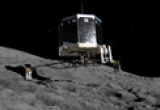Philae has woken up and has given us some news!
After 7 long months, Philae has awoken from hibernation. Its first signs of life reached Earth on Saturday evening (June, 13th) then again the following night. The hope to see Philae awake again and communicating has just come true.
The information transmitted (“housekeeping” data) indicate the good general state of Philae and its worthiness for the continuation of scientific analyses. The two Data Processing Units (primary 'nominal', and redundant) are operational and the internal temperature is sufficient to allow powering on the various subsystems and recharging the batteries. Energy from the solar panels (peaking at 25W) will allow operations with satisfactory performance - in particular they appear not to be coated in light-absorbing organic dust nor reflecting water ice, despite the current high cometary activity -, essential functionalities remain unhindered.
Data transmission from Philae to the Rosetta orbiter occurred within very short communication windows (85 sec on the first pass, even less on the second). The likely cause is geometric obstruction: because of the comet's increased activity, Rosetta had to be cast off to a safe distance of 200 km, putting hard constraints on the fine pointing necessary to communicate with Philae (and of which the location at the surface is not accurately known). A lot of hard work lies ahead optimizing Rosetta's attitude (orbit and distance to nucleus) in the coming days in order to insure communication windows long enough (tens of minutes) each 12-hour long cometary day. These will allow sending commands to Philae containing the sequences of scientific analyses and observations which have been prepared and tested at ground-based facilities. Once carried out, these measurements also need to be transmitted back to Rosetta and then relayed to Earth.
Amongst the first batch of new observations planned are landscape images from the CIVA Cameras under different lighting conditions than before. These will allow characterizing the environment in the immediate vicinity of Philae. Later on, surface material should be sampled, collected and analysed, hopefully allowing the full identification of the cometary nucleus composition.
For the Philae mission and its technical and science teams - of which IAS is heavily involved -, the incredible adventure continues!
Contact at IAS: Jean-Pierre Bibring
ESA Rosetta blog post : https://www.esa.int/Science_Exploration/Space_Science/Rosetta/Rosetta_s_lander_Philae_wakes_up_from_hibernation
CNRS/INSU press release : http://www.insu.cnrs.fr/node/5367
[[{"type":"media","view_mode":"media_original","fid":"389","attributes":{"alt":"","class":"media-image","height":"563","style":"margin-left: 50px; font-size: 13.0080003738403px; line-height: 1.538em; width: 1000px; height: 563px;","typeof":"foaf:Image","width":"1000"}}]]
Artist's view of the landing of Philae (the actual landing site is steeper than shown here). Credit: ESA/ATG medialab.




